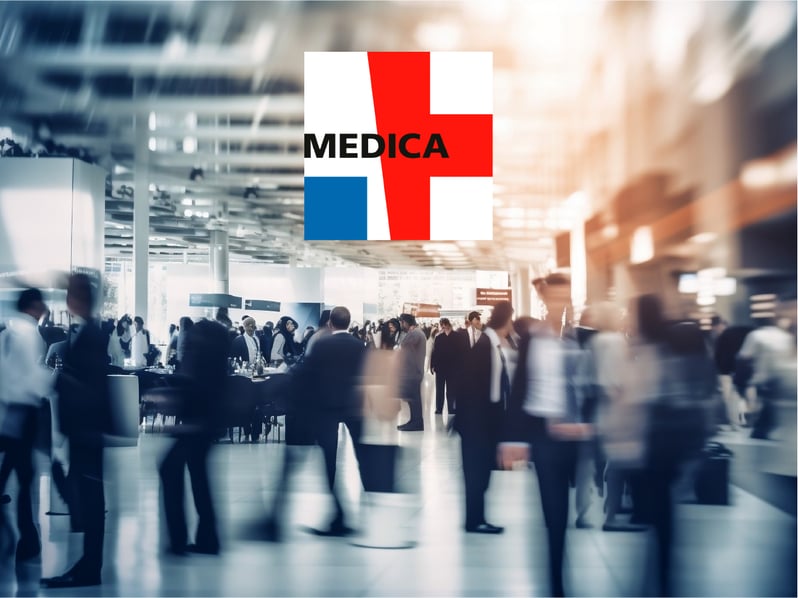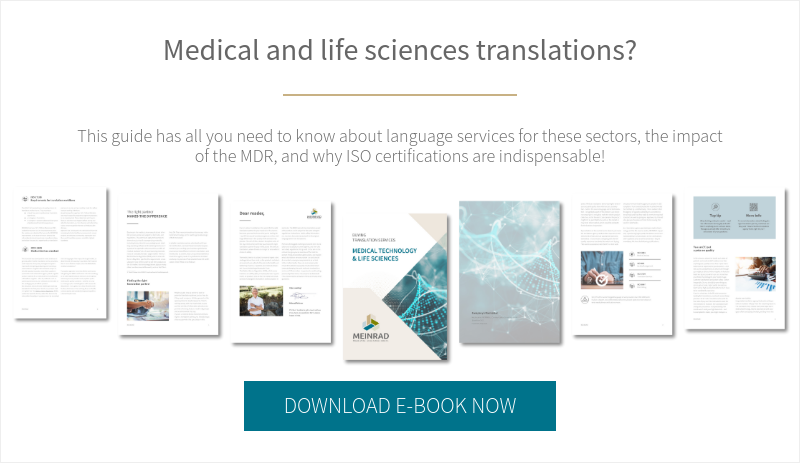
Over a period of four days, 83,000 visitors from the global life sciences industry gathered in Düsseldorf for MEDICA and COMPAMED 2023 – including MEINRAD! This year’s trade fair, an opportunity for leading experts to share ideas and experiences, featured 6,000 exhibitors from around the world and a comprehensive program of events for the hordes of visitors. MEINRAD was based in the Austrian Experts’ Corner of the Advantage Austria stand alongside the Human Technology Styria cluster and the LISAvienna platform. Here are our key takeaways, plus the latest trends in the life sciences industry.
It all began on Monday 13 November, when an excited Lara Tosoni (CRO) and Christian Waldmann (CCO) took their places at our stand in Hall 9 for MEDICA 2023. There were an incredible 15 halls to accommodate all the businesses exhibiting at MEDICA 2023, turning the venue into a vast hub where key players in the life sciences industry could meet and exchange ideas. Meanwhile, COMPAMED alone played host to 735 businesses from the medical technology supplier sector.
Our initial thoughts were that MEDICA is without question the ultimate life sciences trade fair for manufacturers, suppliers, cluster associations, research institutions and end users. Huge national pavilions quickly strengthened this impression as to where the MedTech industry appears to be going: carry on reading to find out more.
Global market leader in MedTech
Germany’s position as the leading MedTech market in Europa attracted lots of international businesses – which perhaps isn’t that surprising when the German market’s export share is around 70%. Key markets include the DACH region, Indonesia and particularly China, which it quickly became clear was represented in large numbers at MEDICA. Experts believe the Asia region offers huge potential as a result of its ageing population, the increasing emergence of a middle class, the high willingness to invest and the substantial demand for health services. This huge investment market in Asia often leads to European businesses being bought out so that Asian corporations can gain a foothold in the European market. And Asia is even on course to overtake Europe as the world’s second biggest MedTech market. That means any MedTech manufacturer with an early presence in emerging markets will have a leading position in the life sciences industry in future.
European market positioning and the MDR
In light of the expansion of Asian businesses into the European market, one issue in particular came up again and again in our discussions with other trade fair participants: the Medical Device Regulation. The MDR imposes stricter requirements on medical device manufacturers before their products can be launched onto the EU market, and because it regards product documentation (such as IFUs) as part of the product, manufacturers looking to sell their medical devices across the EU must get this documentation translated into all 24 official EU languages. And the requirements for these translations shouldn’t be underestimated – labels, instructions and safety information must be clear and accurate. But even though this is a crucial part of the overall process, it’s often overlooked. And that’s where MEINRAD comes in.
How visible is the translation industry?
MEDICA showed us that translation services are marginalized within the overall marketing cycle. So increasing the visibility of the language services sector is vital, especially given the MDR regulations – and ISO 13485 certification also shouldn’t be neglected when choosing a language service provider. Our discussions made clear that people are very familiar with this certification, and that both manufacturers and OEMs consider it to be extremely important. Digitalization and AI were hot topics at MEDICA, as the hope is that digital technology will help detect diseases earlier and allow them to be treated more quickly and more cost-effectively. The MedTech industry has set targets for using digital technology and AI to make more accurate diagnoses, to save time and money, and last but not least to increase patient satisfaction and quality of life. And that brings us full circle to the translation industry: the top priority in life sciences translations is quality, because the health and safety of patients matters more than anything else.
What makes MEDICA unique
The size and global scale of MEDICA 2023, with people of countless nationalities from all over the world, will live long in our memories. That alone underlines the enormous importance of being able to communicate in multiple languages. The matchmaking platform offered to exhibitors before the trade fair for networking purposes was very helpful, but our main thanks go to our stand partners for a whirlwind four days. We were based in the Austrian Experts’ Corner of the Advantage Austria trade promotion organization stand, where we were delighted to be joined by the Human Technology Styria cluster association, the Austrian Business Agency (ABA) and the LISAvienna (Life Sciences Austria) platform and to have lots of fascinating discussions with new contacts. A big thank you to the Austrian Economic Chamber (WKO) and to MEDICA for organizing the trade fair – we can’t wait for MEDICA 2024!
Source: https://www.advantageaustria.org/de/zentral/publikationen/ae/publikationen/169_Medical_Technologies.pdf
Main image © Adobe Stock, MEDICA logo


